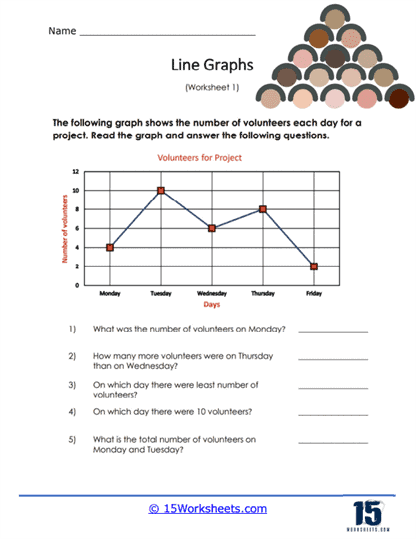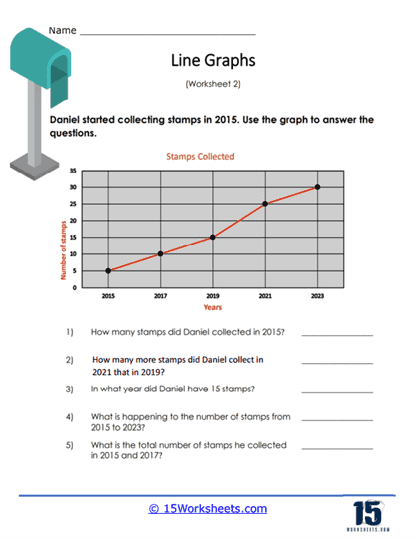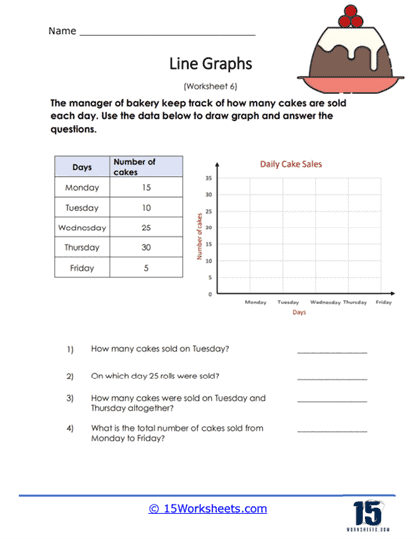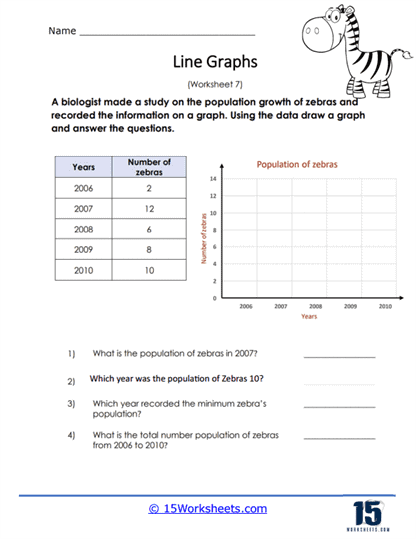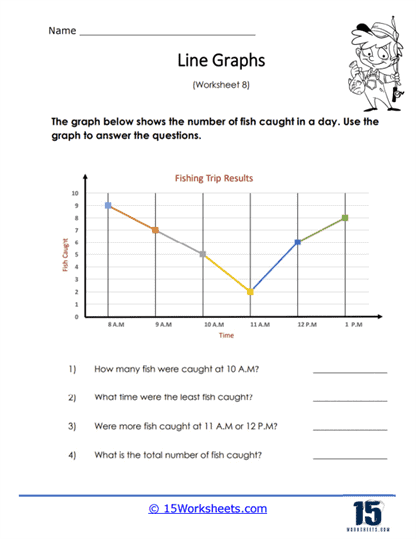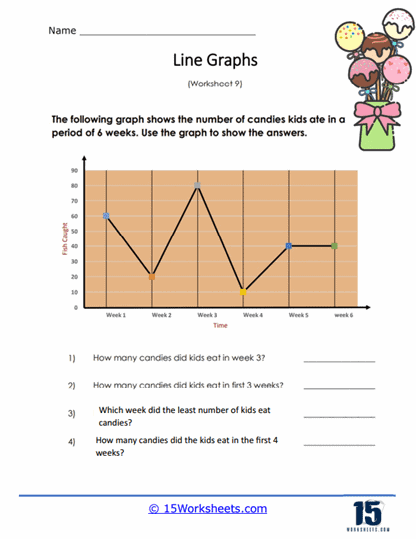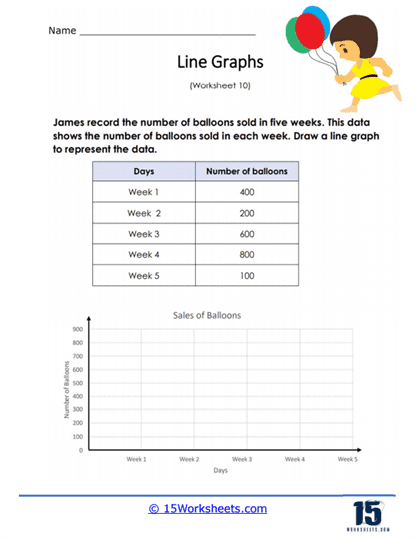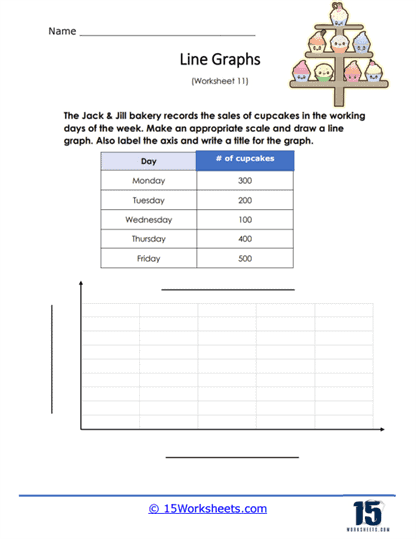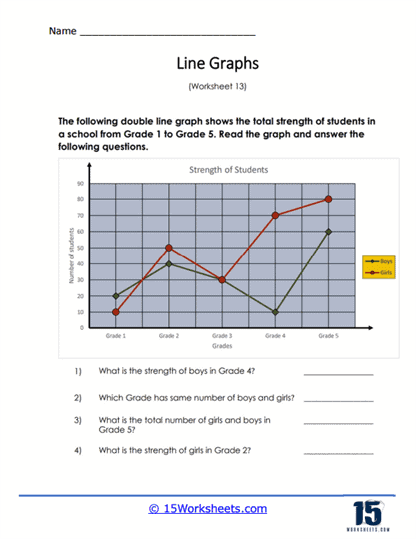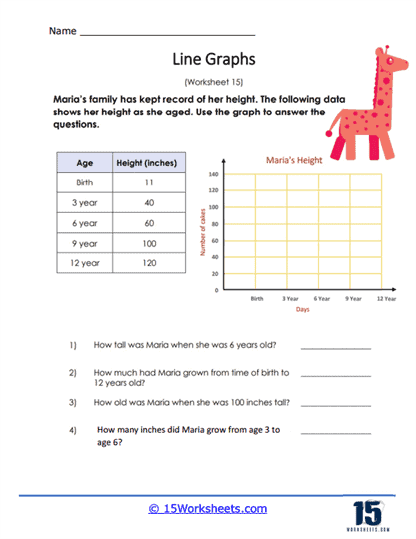Line Graphs Worksheets
About These 15 Worksheets
These line graph worksheets can help students learn and practice how to read, interpret, and create line graphs. A line graph is a type of chart used to display information that changes over time. They are often used in statistics, science, business, and many other areas.
These worksheets typically contain a series of exercises or problems that students must solve based on the interpretation of premade line graphs or data charts that must be formed into a line graph. These exercises may involve:
Understanding Data – Reading a given line graph and answering questions about the data presented. For example, identifying trends over time, determining the highest or lowest values, or extrapolating future values based on the graph.
Creating Line Graphs – Creating their own line graphs from a set of data. This could involve learning how to plot data points on a graph, draw lines connecting these points, and correctly label the x and y axes.
Complex Uses – Interpreting complex or multi-line graphs, where multiple sets of data are represented on the same graph. Real-life application problems where students might need to construct or interpret a line graph as part of solving the problem.
The primary goal of these worksheets is to enhance students’ understanding of line graphs and their uses, helping to develop their analytical skills and ability to interpret graphical data.
What Are Line Graphs?
Line graphs, also known as line charts or line plots, are a type of graphical representation used to display data that changes over time or across a continuous variable. In a line graph, data points are plotted on a two-dimensional plane, with the x-axis typically representing time or an independent variable, and the y-axis representing the dependent variable. The data points are connected with lines to illustrate the trend, pattern, or relationship between the variables.
Line graphs are particularly useful for visualizing trends, fluctuations, and patterns in data over time or across continuous variables. They can help identify the direction and magnitude of changes, as well as reveal any correlations or relationships between variables.
Some common uses of line graphs include:
Finance – Line graphs are often used to track stock prices, exchange rates, or economic indicators like GDP growth and unemployment rates over time.
Research – Researchers can use line graphs to visualize changes in experimental data, such as temperature, pressure, or concentration, over time or as a function of another variable.
Healthcare – Line graphs can be used to track the progression of diseases, patient recovery, or the effectiveness of a treatment over time.
Environmental Studies – Line graphs can help visualize changes in climate data, such as temperature, precipitation, or air quality, over time or across geographic regions.
School – Teachers and students can use line graphs to represent data from experiments, to analyze trends in test scores, or to track progress over time.
When creating a line graph, it’s important to choose an appropriate scale for the axes, label the axes clearly, and select a suitable line style or marker to represent the data points. Additionally, multiple datasets can be plotted on a single line graph for comparison, but it’s essential to use different line styles, colors, or markers to distinguish between the datasets.
How to Spot Trends
Spotting trends in line graphs involves examining the graph for patterns, direction, and magnitude of changes. Here are some steps to help you identify trends in line graphs:
Overall Direction – Look for a general movement in the data points, either upward, downward, or relatively constant. An upward trend indicates an increase in the dependent variable, a downward trend indicates a decrease, and a constant trend indicates little or no change.
Identify Local Trends – In addition to the overall trend, there may be shorter-term trends or fluctuations within the data. Look for smaller upward or downward movements, which might be seasonal or periodic variations.
Steepness of the Lines – The slope of the lines connecting the data points can give you an idea of the magnitude of the change. Steeper lines indicate more rapid changes, while flatter lines indicate slower changes.
Look for Patterns – Some line graphs may exhibit repeating patterns or cycles. These patterns can be regular (e.g., seasonal fluctuations) or irregular (e.g., sudden spikes or drops).
Detect Outliers – Outliers are data points that are significantly different from the overall trend or pattern. Spotting these outliers can help you identify potential anomalies or unique events in the data.
Compare Multiple Datasets – If the line graph contains multiple lines representing different datasets, compare the trends, patterns, and magnitudes of change between them. This can provide insights into the relationships or differences between the datasets.
Consider the Context – To accurately interpret trends in a line graph, it’s essential to consider the context of the data, including the variables being measured, the time frame, and any external factors that might influence the data.
By carefully examining line graphs with these steps in mind, you can effectively spot and analyze trends, which can help inform decision-making, forecasting, and understanding the underlying factors that drive changes in the data.

